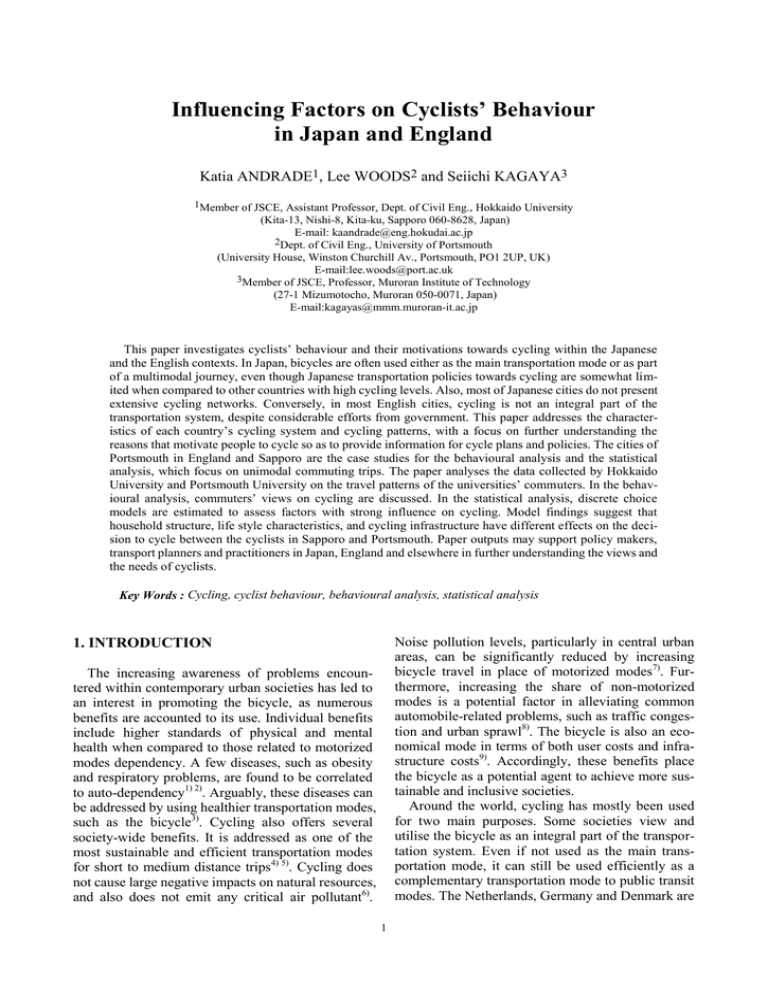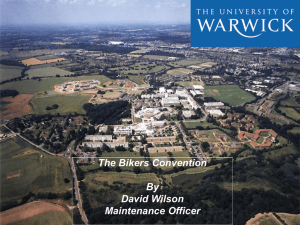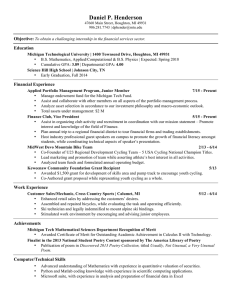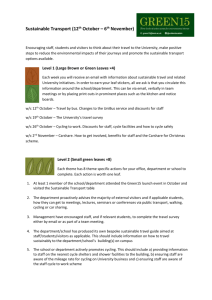Influencing Factors on Cyclists’ Behaviour in Japan and England Katia ANDRADE
advertisement

Influencing Factors on Cyclists’ Behaviour in Japan and England Katia ANDRADE1, Lee WOODS2 and Seiichi KAGAYA3 1Member of JSCE, Assistant Professor, Dept. of Civil Eng., Hokkaido University (Kita-13, Nishi-8, Kita-ku, Sapporo 060-8628, Japan) E-mail: kaandrade@eng.hokudai.ac.jp 2Dept. of Civil Eng., University of Portsmouth (University House, Winston Churchill Av., Portsmouth, PO1 2UP, UK) E-mail:lee.woods@port.ac.uk 3Member of JSCE, Professor, Muroran Institute of Technology (27-1 Mizumotocho, Muroran 050-0071, Japan) E-mail:kagayas@mmm.muroran-it.ac.jp This paper investigates cyclists’ behaviour and their motivations towards cycling within the Japanese and the English contexts. In Japan, bicycles are often used either as the main transportation mode or as part of a multimodal journey, even though Japanese transportation policies towards cycling are somewhat limited when compared to other countries with high cycling levels. Also, most of Japanese cities do not present extensive cycling networks. Conversely, in most English cities, cycling is not an integral part of the transportation system, despite considerable efforts from government. This paper addresses the characteristics of each country’s cycling system and cycling patterns, with a focus on further understanding the reasons that motivate people to cycle so as to provide information for cycle plans and policies. The cities of Portsmouth in England and Sapporo are the case studies for the behavioural analysis and the statistical analysis, which focus on unimodal commuting trips. The paper analyses the data collected by Hokkaido University and Portsmouth University on the travel patterns of the universities’ commuters. In the behavioural analysis, commuters’ views on cycling are discussed. In the statistical analysis, discrete choice models are estimated to assess factors with strong influence on cycling. Model findings suggest that household structure, life style characteristics, and cycling infrastructure have different effects on the decision to cycle between the cyclists in Sapporo and Portsmouth. Paper outputs may support policy makers, transport planners and practitioners in Japan, England and elsewhere in further understanding the views and the needs of cyclists. Key Words : Cycling, cyclist behaviour, behavioural analysis, statistical analysis Noise pollution levels, particularly in central urban areas, can be significantly reduced by increasing bicycle travel in place of motorized modes7). Furthermore, increasing the share of non-motorized modes is a potential factor in alleviating common automobile-related problems, such as traffic congestion and urban sprawl8). The bicycle is also an economical mode in terms of both user costs and infrastructure costs9). Accordingly, these benefits place the bicycle as a potential agent to achieve more sustainable and inclusive societies. Around the world, cycling has mostly been used for two main purposes. Some societies view and utilise the bicycle as an integral part of the transportation system. Even if not used as the main transportation mode, it can still be used efficiently as a complementary transportation mode to public transit modes. The Netherlands, Germany and Denmark are 1. INTRODUCTION The increasing awareness of problems encountered within contemporary urban societies has led to an interest in promoting the bicycle, as numerous benefits are accounted to its use. Individual benefits include higher standards of physical and mental health when compared to those related to motorized modes dependency. A few diseases, such as obesity and respiratory problems, are found to be correlated to auto-dependency1) 2). Arguably, these diseases can be addressed by using healthier transportation modes, such as the bicycle3). Cycling also offers several society-wide benefits. It is addressed as one of the most sustainable and efficient transportation modes for short to medium distance trips4) 5). Cycling does not cause large negative impacts on natural resources, and also does not emit any critical air pollutant6). 1 examples of European countries where cycling accounts for high daily shares. Among Asian countries, Japan and China present significant cycling rates. However, in many other countries cycling has been merely seen as a means of recreation and is rarely used for daily travel. Examples are the United States, Australia and Great Britain where statistics suggest insignificant bicycle shares. The aim of this study is to further understand active cyclists’ behaviour and their perceptions of the cycling system, so as to provide information for cycle plans and policies. The approach includes investigating the behaviour of cyclists from different countries, which present distinct cycling levels, cycle services and facilities. This approach allows for a deeper look at the reasons that motivate travellers to cycle based on different cycle environments and levels of service. The outputs of this paper will contribute to practitioners and planners to better understand individuals’ motivations towards cycling. Non-cyclists are also considered, and their views are assessed as a way to improve the cycling system. The paper analyses data collected by Hokkaido University (HU) and Portsmouth University (PU, England) on the travel patterns of the universities’ commuters. Behavioural and statistical analyses are developed. The results of the mode choice models highlight factors with strong influence on cycling. Household and life style characteristics, as well as cycling infrastructure appear to have strong influence on the decision to cycle. Fig.1 Index of average trips per person by mode in Great Britain [National Travel Survey, 2011]. Fig.2 Index of average distance driven per person by mode in Great Britain [National Travel Survey, 2011]. Portsmouth is a highly compact city with the highest population density of any city in the UK at 46.4 persons per hectare compared to 45.6 in London12). Much of the housing in Portsmouth was built in the late 19th and early 20th century period to serve workers at the military dockyard. High proportions cycled to the military dockyard from this high density housing, indeed some roads were closed to allow for cyclists to leave the dockyard in the evening. While the dockyard remains a major employer in the city, the number of employed by other industries in the city has increased. Particularly, the numbers of people working or studying at the University of Portsmouth have increased rapidly over the last fifteen years and currently 22,622 students and 3,000 staff study or work at the institution. It is believed therefore that the University of Portsmouth staff and students form an interesting population when studying the cycling behaviours in Portsmouth. Portsmouth City Council has undertaken a number of schemes to encourage greater cycling including the introduction of a 20mph speed limit across the city 13), improved cycle parking facilities, new cycle lanes and other educational and promotional programmes 2. CYCLING TRENDS Japan and England present considerable distinct cycling trends. Even though both countries show predominant use of motorized vehicles in central urban areas, the bicycle is used far more for daily-travel in Japan than in Great Britain. Not only does cycling account for a small proportion of trips, Great Britain has been experiencing a recent decline in cycling10). On average, national statistics show that currently residents make as few as 14 bicycle trips per year, compared with 18 trips per year in 199511). This decline is more pronounced than the decline in trips by car over the same period as can be seen in Figure 1. However, average distance travelled per person per year by bike in 2010 were very similar to those in 1995 as can be seen in Figure 2, thus suggesting that while fewer trips are being made by bicycle over the period, the length of those trips has increased. 2 responses from non-cyclists and to look at cyclists’ behaviour when performing non-commuting trips. The final data bases include the responses from 410 (HU) and 515 (PU) individuals. These figures represent 2% the universities’ commuters. While the exact number of responses needed to undertake the analysis cannot be known without a-priori knowledge of the range of responses, various guides suggest a sample size of 104 plus the number of independent variables included in the regression analysis (Tabachnick and Fidell, 2007) or twenty times the number of independent variables in the model (Garson, 2010). This would relate to 124 and 400 responses respectively, as being required for the analysis presented here. in order to increase cycling in the city against the longer term decline, both in Portsmouth and nationally. Conversely, the bicycle is a widely accepted transportation mode throughout Japan. National statistics indicate that 17% of weekday-trips are made by bicycle in the country14). Also, the bicycle accounts for almost 19% of trips within the three major metropolitan areas of Tokyo, Osaka and Nagoya. Trips by private car account for 25% within the same metropolitan areas. Sapporo metropolitan area has fairly similar cycling rates compared to national rates. Non-motorized modes, including cycling and walking, play an important role when counting short to medium distance trips within downtown Sapporo city. Figure 3 highlights that non-motorized trips account for the great majority of all trips in the surroundings of Sapporo Station area. Furthermore, bicycle trips doubled between 1994 and 2006 against a 26% reduction in car trips and stable rates of public transit trips during the same period15). 4. BEHAVIOURAL ANALYSIS Non-motorized trips account for the majority of HU and PU commuting trips. Tables 1 and 2 summarize the mode split segregated by status. They reveal higher cycling rates among student than staff in HU, while the opposite is observed in PU. It is also noticed that car share is considerably higher among staff than students. The greater preference for non-motorized modes is coherent with commuting distances and HU transport policies. Most commuters live within the neighbourhood of the university. The average commuting time is 18 minutes. HU transport policies include car use restrictions. Also, it has been motivating people to cycle by creating a more cycle-friendly environment. The proportions of PU respondents cycling is lower than that of HU respondents despite having higher levels of bicycle ownership, similar age profile and similar proportions of undergraduate, graduate and staff. PU respondents were more likely to drive to the University, particularly University staff and post graduate students. PU students were far more likely than their HU counterparts to walk to the University, whereas PU staff were far less likely to have walked compared to HU staff. This may reflect the residential location of staff and students in Portsmouth with many students living in student halls of residence or suburbs close to the University, while many staff at the University appeared to live in more distant suburbs of the city, or in neighbouring towns and cities such as Havant or Fareham. 3. DATA Hokkaido University Transport Survey (HUTS) and Portsmouth University Transport Survey (PUTS) were carried out in April and June 2011, respectively. Home mail box delivery, direct handled questionnaires and on line delivery approaches were used in the surveys. The different approaches were employed to increase the response rate and to achieve variety among respondents. Mail box delivery focused on residents living at a cycling distance from the campuses in order to achieve a high number of responses from active cyclists. The surveys focused primarily on cycling issues and cyclists’ views and attitudes towards cycling. However, they also included several other transportation aspects both in order to gather 5. STATISTICAL ANALYSIS Mode choice models are estimated to further investigate the influence of personal characteristics, travel behaviours and attitudes on commuting mode choices. Particular attention is given to factors with Fig.3 Mode share by trip purpose in Sapporo downtwon [Person Trip Survey, 2006]. 3 Table 1 Mode split among HU commuters (%) Transport Undergraduate Graduate Mode Bicycle 69.9 64.3 Walk 7.8 19.6 Bus 3.0 1.4 Subway 10.2 9.8 Train 8.4 2.8 Car 0.6 2.1 Table 2 Mode split among PU commuters (%) Transport Undergraduate Graduate Mode Bicycle 19.7 23.4 Walk 61.4 47.9 Bus 5.4 5.3 Subway 0.0 0.0 Train 4.6 8.5 Car 6.2 11.7 Other 2.7 3.2 utility functions for the MNL and NL models are not described here, but can be found in the broad literature on this topic16-19). Staff 29.6 32.1 4.9 11.1 4.9 17.3 (2) Models’ Specification The MNL and NL mode choice models include a set of four alternatives: bicycle, walk, public transport (aggregation of bus, subway and train), and private car. For the NL model, two nests include the alternatives of bicycle and walk (non-motorized nest); and public and car (motorized nest). The attribute variables are classified in four groups: Staff 40.6 14.2 3.8 0.0 5.7 33.0 2.8 Group1: Personal and household characteristics Group2: Travel behaviour and life style variables Group3: Bicycle infrastructure and services variables Group4: Accessibility variables The focus of this paper is to investigate the particular effect of attribute variables in the alternatives. In this, all input attributes are mode specific. All variables in groups 2 and 3 are bicycle-specific. strong influence on cycling, thus attributes related to life style, bicycle infrastructure and services are input to the models as bicycle-specific variables. 6. MODELS’ RESULTS AND DISCUSSION (1) Multinomial Logit and Nested Logit Models Discrete choice modelling framework is used in this paper to estimate transport mode choice models in the forms of Multinomial Logit (MNL) and Nested Logit (NL) models16). Random utility theory is assumed to derive such models. This theory suggests that choice preferences towards a certain alternative can be shown through its utility. Also, it is assumed that the alternative with the highest utility is chosen by the decision maker17). The utility of a certain alternative is composed by observed and unobserved (random) terms. The observed term of the utility includes a set of observed variables related to the alternative and the decision maker; and a vector of alternative coefficients. The random term includes the uncertainties related to the analyst’s limited information on individual preferences18). The standard logit model assumes that the decision maker selects one among a set of independent alternatives, while assuming that the uncertainties are independently and identically distributed. Whilst in the NL structure, the alternatives are grouped in different nests according to their similarities, thus relaxing the above mentioned assumption of independent and identical uncertainties19). The models also differ in complexity, being the MNL model extensively used because of its simplicity in terms of computation and interpretation of estimates when compared to the NL model. By considering the benefits of each model structure, it was decided to investigate how they would perform in reflecting the correlations under interest in this study. Details of the derivations of Tables 3 and 4 summarise the models’ outputs for Sapporo and Portsmouth, respectively. The alternative specific constants and variables related to groups 1 to 4 (as above) were added sequentially to the models. Private car is set as the comparison case. The log-likelihood ratio tests show that each set of new input variables increase the explanatory power of the models. Overall, the results of the MNL and NL models are similar, particularly those for models 1, 2, and 3. However, results of models 4, which are the most extensive models, are reasonably different. For both case studies, MNL 4 showed better operational performance than the NL 4, both in terms of the significance of coefficients and goodness of fit. Accordingly, the analysis in this section is based upon MNL 4. All coefficients are sign-coherent, and most of variables are significant at the 0.95 confidence level (critical value is 1.96). A few non-significant variables at this confidence level are kept in the models as they provide insightful information. In group 1, the effect of household structure on cycling appears to diverge between the case studies. Cycling is significantly correlated to single households in Sapporo, while in Portsmouth more people at home seems to influence cycling. This difference might be a result of cultural differences. In Japan, students tend to form single households, rather than the common shared households in the UK. Car availability affects negatively the choice of non-motorized and public modes 4 in both cases, which is an expected result. However, this variable appears to have stronger (statistically more significant) impact on non-motorized and public modes in Portsmouth. For Sapporo data, it is also interesting to note that the coefficient related to car availability for walk mode is higher in magnitude than those for bicycle and public modes. It indicates that people’s decision towards commuting by bicycle and public modes is less likely to be affected by having a car available at home than the decision to walk. Variables in Groups 2 and 3 are bicycle-specific and they reveal insightful information on the cycling choice to campus. Those related to travel behaviour and life style (group 2) are added to the models so as to investigate personal characteristics and propensity to cycle. It is noted that people who practice any kind of physical activities (other than cycling) are also more likely to cycle to campus in Sapporo, but did not appear to be significant for Portsmouth data. It suggests that HU commuters are more likely to perceive the need of exercising as an important factor in their mode choice. Cycling to perform other activities (such as shopping, leisure and business) appears to be strongly correlated to cycling to work, particularly among PU commuters. It is then suggested that cycling is a life style choice, which is attached to a chain effect. Sidewalk cycling has divergent effects between the cases. For HU data, the model reveals that people who cycle more frequently in sidewalks are more likely to commute by bicycle. It may be correlated to the cyclists’ feeling of safety while cycling in Sapporo, which also shows strong influence in the decision to cycle (group 3). Group 4 includes accessibility variables. On one hand, commuting time coefficients for bicycle and walk are negative, which is a sensible output. People tend to choose the mode that presents the least travel time if all else is equal. On the other hand, the coefficients related to walking distance to the closest public transit stations affect cycling positively. These outputs suggest that people are more likely to cycle to stations if the walking distance is longer. Even though these variables are not exclusively related to commuting trips, it is interesting to note that they are correlated to the bicycle choice to campus. April 2011 and June 2011, respectively. They highlight characteristics of the transport system and the households, and also individual perceptions that affect students and staff decisions towards cycling. The key findings are summarized as follows. Safety perception, as largely discussed in the literature9) 20) 21), also plays an important role on the decision to cycle among travellers in Sapporo and Portsmouth. However in Japan, unlikely other countries including the UK, cyclists might perceive safety as a result of riding on sidewalks rather than sharing roadways with motorized vehicles. In this aspect, Sapporo is particularly convenient for cycling with its spacious sidewalks. Moreover, priority for cyclists in road intersections contributes to the safety perception. Yet, the respondents of the surveys cite that implementing exclusive cycle routes, along with improving the existing cycle lanes and increasing the number of free bicycle parking lots, would contribute to more cycle-friendly journeys, both in Sapporo and Portsmouth. Life style characteristics are directly correlated to the decision to cycle. It is noted that practicing physical activities, other than cycling, motivate people to cycle to campus. However, in Sapporo people appear to be more aware of the benefits associated to frequent cycling. Previous studies have highlighted that health-conscious travellers are likely to use non-motorized modes8) 22). Additionally, cycling to perform other non-working related activities appears to be strongly correlated to cycling to work. It is then suggested that cycling is a life style choice, which is attached to a chain effect. Household structure appears to have different effects on the decision to cycle, probably as a result of cultural differences among the countries. Single households significantly influence the decision to cycle in Sapporo, which does not occur in Portsmouth. It is observed that a considerable part of the population in Sapporo, particularly students and young professionals, form single households, thus likely motivating the use of bicycles. Conversely, single population commonly share houses in European and North American countries. The findings of this study provide insightful information on the behaviour of active cyclists. This information may be used by government bodies and transport practitioners in Japan, in England and elsewhere when planning for more sustainable and cycle-friendly urban environments. 7. CONCLUSIONS This paper presents the results of behavioural and statistical analyses, which focus on the behaviours and attitudes of active cyclists within the Japanese and the English urban contexts. The analyses are based on the Hokkaido University and the Portsmouth University transport surveys conducted in 5 REFERENCES 1) 2) 3) 4) 5) 6) 7) 8) 9) 10) 11) 12) 13) ALA American Lung Association. State of the Air 2006. http://www.stateoftheair.org/. Accessed Jan. 6, 2011. Samimi et al. Effects of transportation and built environment on general health and obesity. Amir Samimi, Abolfazl Mohammadian, Seyedali Madanizadeh. Transportation Res. Part D, 2009. ALA American Lung Association. State of the Air 2010.http://www.stateoftheair.org/. Accessed Jan. 8, 2011. Exploratorium. Science of Cycling: Human Power. http://www.exploratorium.com/cycling/humanpower1.html. Accessed Dec. 15, 2011. Whitt, F., and D. Wilson. Bicycling Science. Cambridge, Massachusetts, Massachusetts Institute of Technology, 1982. Burden, D. Building Communities with Transportation. In Transportation Research Record: Journal of the Transportation Research Board, No. 1773, pp. 5-20, 2001. Shahan, Z. D. The Relationship between Bicycling Facilities and Bicycle Travel: A Comparative Study in the United States and the Netherlands. Master Thesis, University of North Carolina at Chapel Hill, 2007. Akar, G., and Clifon, K. The Influence of Individual Perceptions and Bicycle Infrastructure on the Decision to Bike. CD-ROM. Transportation Research Board of the National Academies, 2009. Pucher, J., and R. Buehler. Making Cycling Irresistible: Lessons from the Netherlands, Denmark and Germany. Transport Reviews, Vol. 28, No.4, pp. 495-528, 2007. DfT UK Department for Transport (2009) National Travel Survey 2009: How People Travel. http://www.dft.gov.uk/pgr/statistics/datatablespublications. Accessed Jan. 04, 2011. DfT UK Department for Transport (2007) Cycling: Personal Travel Factsheet 2007. http://www.dft.gov.uk. Accessed Dec. 15, 2010. ONS, 2001. UK National Census 2001, Office of National Statistics. Accessed 1June, 2011 from http://www.ons.gov.uk/ons/datasets-and-tables/index.html DfT UK Department for Transport (2011) Interim Evalua- 14) 15) 16) 17) 18) 19) 20) 21) 22) 6 tion of the Implementation of 20 mph Speed Limits in Portsmouth. http://webarchive.nationalarchives.gov.uk/+/http://www.dft .gov.uk/pgr/roadsafety/research/rsrr/theme4/interimeval20 mphspeedlimits.pdf. Accessed Aug. 30, 2011. MLIT Ministry of Land, Infrastructure, Transport and Tourism. 10thMetropolitan Areas Transportation Census. 2007. Accessed Dec. 12, 2010. http://www.mlit.go.jp/sogoseisaku/transport/koukeika/02/ri you_00.html. Sapporo DfT Department for Transport. Person Trips Survey Outputs. 2006. Accessed Feb. 15, 2011. http://www.douou-pt.jp/master/img/pdf/MP02.pdf. Bierlaire, M. (2008) An introduction to BIOGEME Version 1.6, biogeme.epfl.ch Meyer, M. D., and J. Miller. Urban Transportation Planning. Mc Grow Hill, United States, 2001. Ben-Akiva, M. E., and S. R. Lerman. Discrete Choice Analysis: Theory and Application to Travel Demand. MIT Press, Cambridge, 1985. Ortuzar, J. D., and L. G. Willumsen. Modelling Transport. 3rd Edition. John Wiley & Sons, England, 2001. Pucher, J., and R. Buehler. Cycling for Everyone: Lessons from Europe. In Transportation Research Record: Journal of the Transportation Research Board, No. 2074, Transportation Research Board of the National Academies, Washington, D.C., pp. 58-65, 2008. Hall, L., and J. LaMondia. Evaluating the Safety of Shared-Use Paths: Results from Three Corridors in Connecticut. In Transportation Research Record: Journal of the Transportation Research Board, No. 1939, Transportation Research Board of the National Academies, Washington, D.C., pp. 99-106, 2005. Dill, J. K. Voros. Factors Affecting Bicycling Demand: Initial Survey Findings from the Portland Region. In Transportation Research Record: Journal of the Transportation Research Board, No. 2031, Transportation Research Board of the National Academies, Washington, D.C., pp. 9-17, 2007. TABLE 3 Outputs of the NL and MNL models: Sapporo case. Variable NL 1 NL 2 NL 3 ASC*(base case fixed on Car) Bicycle 3.770 1.720 0.976 (2.37) (2.28) (1.24) Walk 3.160 2.590 2.460 (0.45) (4.61) (3.30) Public 2.950 2.860 2.850 (4.83) (3.71) (4.17) Group 1: Personal and household characteristics Staff – Car 2.150 1.770 1.690 (3.72) (3.04) (2.99) Single household– Bicycle 1.830 1.990 2.020 (3.90) (5.36) (4.82) Single household – Walk 1.690 1.610 1.580 (1.48) (3.94) (3.58) Car availability – Bicycle -1.030 -0.733 -0.777 (-4.28) (-2.66) (-1.76) Car availability – Walk -1.040 -1.090 -1.110 (-4.06) (-3.75) (-2.33) Car availability – Public -0.502 -0.519 -0.542 (-2.39) (-2.39) (-1.36) Group 2: Travel behavior and life style** Cycle to perform other activ1.850 1.590 ities (4.35) (5.32) Cycle more frequently in 1.140 0.676 sidewalks (3.95) (2.15) Practice physical activities 0.350 0.359 twice a week (1.31) (1.16) (other than cycling) Group 3: Bicycle infrastructure and services** Bike paths in the way to 0.861 campus (2.72) Feel safe while cycling in 1.090 Sapporo (3.56) Carry bikes in public modes 0.960 (3.15) Group 4: Accessibility variables Commuting time– Bicycle Commuting time – Walk Walking dist. to train station – Bicycle Walking dist. to subway station – Bicycle Goodness of fit Initial log-likelihood -555.90 -555.90 Final log-likelihood -370.85 -309.08 Number of observations: 401 * ASC: Alternative Specific Constants ** Bicycle specific variables *** Constant log-likelihood (i.e. ASC only): -424.293 t-statistics shown in parentheses -555.90 -291.02 NL 4 MNL 1 MNL 2 MNL 3 MNL 4 4.050 (3.90) 5.090 (4.79) 2.900 (5.79) 3.640 (6.06) 2.530 (3.98) 2.950 (4.83) 1.540 (2.31) 2.460 (3.83) 2.850 (4.61) 0.976 (1.40) 2.460 (3.79) 2.850 (4.56) 3.630 (4.12) 4.870 (5.65) 2.900 (4.76) 1.950 (3.23) 1.090 (2.40) 1.070 (2.27) -0.588 (-1.78) -0.959 (-2.72) -0.521 (-2.23) 2.150 (3.72) 1.850 (5.49) 1.590 (3.86) -1.030 (-4.19) -1.040 (-3.72) -0.502 (-2.39) 1.750 (3.01) 2.020 (5.32) 1.580 (3.74) -0.713 (-2.54) -1.100 (-3.61) -0.520 (-2.39) 1.690 (2.91) 2.020 (5.01) 1.580 (3.60) -0.777 (-2.76) -1.110 (-3.61) -0.542 (-2.45) 1.900 (3.19) 1.110 (2.24) 1.040 (2.12) -0.577 (-1.62) -1.030 (-2.85) -0.529 (-2.25) 2.030 (7.46) 1.240 (4.85) 0.336 (1.26) 1.590 (5.34) 0.676 (2.34) 0.359 (1.69) 1.400 (4.07) 0.725 (2.37) 0.555 (1.98) 0.861 (2.51) 1.090 (3.48) 0.960 (3.05) 0.893 (2.28) 1.360 (3.77) 0.816 (2.22) 1.090 (2.33) 0.573 (1.86) 0.524 (1.84) 0.762 (2.12) 1.060 (2.30) 0.597 (1.48) -0.129 (-5.94) -0.094 (-5.05) 1.150 (2.85) 0.403 (1.16) -555.90 -240.95 7 -0.138 (-6.19) -0.092 (-4.63) 1.340 (3.39) 0.417 (1.02) -555.90 -370.85 -555.90 -309.26 -555.90 -291.08 -555.90 -237.58 TABLE 4 Outputs of the NL and MNL models: Portsmouth case. Variable NL 1 NL 2 NL 3 ASC*(base case fixed on Car) Bicycle 0.860 -1.160 -1.800 (2.51) (-2.80) (-3.34) Walk 1.550 1.850 1.450 (4.43) (3.85) (4.80) Public 1.950 2.240 2.100 (6.25) (6.00) (6.46) Group 1: Personal and household characteristics Student – Walk 1.300 1.050 1.040 (5.80) (4.50) (4.70) 2 adults household– Bicycle 1.720 1.520 1.690 (5.45) (2.95) (3.84) 2 adults with kids – Car 1.280 1.370 1.350 (3.80) (3.85) (3.60) 3 plus adults – Bicycle 1.430 1.140 1.250 (4.53) (2.80) (2.75) Car availability – Bicycle -3.230 -3.650 -3.510 (-8.51) (-7.31) (-6.35) Car availability – Walk -3.680 -3.780 -3.500 (-9.50) (-9.82) (-10.34) Car availability – Public -3.235 -2.990 -2.980 (-6.01) (-7.05) (-7.01) Group 2: Travel behavior and life style** Cycle to perform other activ3.930 3.160 ities (10.00) (7.25) Cycle more frequently in -0.687 -1.110 sidewalks (2.75) (-2.52) Practice physical activities 0.550 0.464 three or more times a week (1.90) (1.20) (other than cycling) Group 3: Bicycle infrastructure and services** Bike paths in the way to 0.624 campus (1.95) Feel safe while cycling in 1.000 Portsmouth (3.59) Carry bikes in public modes 0.489 (1.15) Group 4: Accessibility variables Commuting time– Bicycle Commuting time – Walk Walking dist. to train station – Bicycle Goodness of fit Initial log-likelihood -754.14 -754.14 Final log-likelihood -557.63 -450.07 Number of observations: 401 * ASC: Alternative Specific Constants ** Bicycle specific variables *** Constant log-likelihood (i.e. ASC only): -424.293 t-statistics shown in parentheses -754.14 -440.05 NL 4 MNL 1 MNL 2 MNL 3 MNL 4 -0.503 (-1.50) 1.270 (3.95) 3.120 (7.57) 0.835 (2.11) 1.480 (4.93) 2.090 (6.41) -1.480 (-2.84) 1.460 (4.96) 2.130 (6.50) -1.810 (-3.34) 1.460 (4.95) 2.130 (6.46) -0.633 (-2.00) 1.470 (4.90) 3.520 (8.04) 0.925 (3.54) 1.670 (3.40) 1.150 (2.87) 1.250 (2.31) -3.430 (-6.14) -3.790 (-9.09) -3.220 (-7.00) 1.150 (5.59) 1.720 (5.27) 1.280 (3.81) 1.480 (4.51) -3.540 (-9.01) -3.720 (-10.30) -3.230 (-7.13) 1.020 (4.59) 1.500 (3.71) 1.380 (3.71) 1.140 (2.86) -3.540 (-7.84) -3.650 (-10.01) -3.190 (-7.05) 1.040 (4.70) 1.690 (3.84) 1.400 (3.70) 1.270 (2.84) -3.450 (-7.35) -3.660 (-10.01) -3.190 (-7.06) 0.934 (4.04) 1.670 (3.66) 1.200 (3.14) 1.250 (2.67) -3.850 (-7.74) -3.890 (-9.59) -3.220 (-7.11) 3.900 (10.51) -0.761 (1.75) 0.548 (1.89) 3.160 (7.24) -1.100 (-2.52) 0.427 (1.40) 3.130 (6.97) -1.070 (-2.34) 0.342 (1.09) 0.633 (1.93) 1.060 (3.09) 0.399 (1.15) 0.703 (1.99) 1.050 (3.03) 0.450 (1.28) 3.121 (6.10) -0.800 (-2.15) 0.250 (1.09) 0.703 (0.95) 1.090 (2.53) 0.450 (0.61) -0.045 (-4.00) -0.055 (-4.52) 0.015 (1.84) -754.14 -420.80 8 -0.061 (-4.26) -0.055 (-5.87) 0.017 (2.79) -754.14 -557.63 -754.14 -450.07 -754.14 -440.76 -754.14 -407.08



